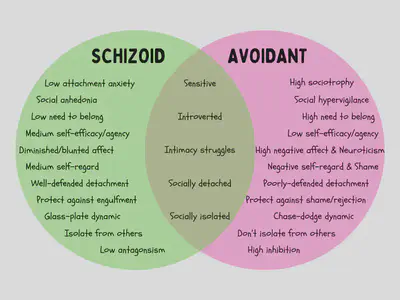Schizoid Personality Disorder vs. Avoidant Personality Disorder

Unlike many personality disorders, avoidant personality disorder didn’t come on the scene until about the 1960s with Millon’s work1 2. It didn’t even appear formally until the DSM-III in 1980 when schizoid personality disorder was split into schizoid, schizotypal, and avoidant3 4 2 🤯. And ever since, there’s been an argument about it2.
History - Kretschmer
It all started with Kretschmer who described schizoid personalities as having three groups of characteristics3 4:
- Core: Unsociable, quiet, reserved, serious (humourless), eccentric
- Hyperaesthesia: Sensitive, timid, shy with fine feelings, nervous, excitable, fond of nature and books
- Anaesthesia: Insensitive, pliable, cold, kindly, honest, indifferent, dull-witted, silent
While the first group is the core of schizoid and runs “like a scarlet thread through the whole of schizoid characterology,” the second and third groups of features were noted to be on a continuum3. So sensitivity and insensitivity stand in opposition to each other, and schizoids move along the spectrum, making their position unstable3 4. The tension between the two is what is distressing. It’s a conflict, just like the psychodynamic conceptualization.
Kretchmer stated, “The majority of schizoids are not either oversensitive or cold, but . . . they are over-sensitive AND cold at the same time AND. . . in quite different relative proportions3.” The sensitivity levels exist within the same turtle, it just depends on how comfortable/safe the turtle feels. When the turtle is out looking around and showing itself, we see the hyperaesthesia, but when it shuts itself in its shell, we see the anaesthesia.
Splitting Up Schizoid and Avoidant
Now, this is not what Millon decided. He decided that Kretchmer really meant hyperaesthesia and anaesthesia were two different personalities, avoidant and schizoid respectively5. And he basically noted that he was on the DSM taskforce and everyone else wasn’t, so they “don’t get it5.” Yet, this is in contrast to Gunderson’s view3: “In the absence of any clinical, empirical, or even widely accepted theoretical rationale for such a distinction, it is difficult to understand why this category [avoidant personality disorder] was established3.”
Akhtar chimed in and noted that the work of Fairbairn and Kernberg was ignored in splitting up avoidant and schizoid in the DSM, highlighting schizoids use lower level defenses, experience identity diffusion, and have a borderline organization (with more severe childhood trauma), while avoidants use higher level defenses, do not experience identity diffusion, and have a neurotic organization due to ego-syntonic anxiety (aka anxiety becomes intertwined with the personality)6. Akhtar later joined in again and suggested the DSM category of schizoid should be deleted and the DSM category of avoidant should be relabeled schizoid7…And some suggested schizoid just be deleted because they’re not common8, which I think is just rude, but everyone loves to overlook the schizoids 😠. Overall, the split of schizoid and avoidant has been chaotic, and everyone is still confused about it!
But what does the DSM say?
Briefly, the DSM-5-TR criteria for schizoid personality disorder involves social detachment and restricted emotional expression without psychosis or autism9. In contrast, the DSM-5-TR criteria for avoidant personality disorder involves social inhibition, feelings of inadequacy, and hypersensitivity to negative evaluation, which leads to avoidance of social interaction/activities9. While both are socially isolated9 10, avoidants desire relationships and feel deep loneliness, only moving away from closeness with others due to fear of embarrassment/rejection, while schizoids just don’t desire social intimacy as much, preferring aloneness and being content in it9.

Compare and Contrast of Schizoid and Avoidant
There’s clearly an overlap between schizoid and avoidant. They are both detached personalities10 who lean toward an avoidant/dismissive attachment style2. They are introverted2, socially isolated9, and can seem chilly, backwards, or socially awkward10. They can both be extremely sensitive and struggle in relationships involving intimacy2. However, there’s a lot of differences between schizoid personality disorder and avoidant personality disorder, so I made a table…because yay, data!
Differences Between Schizoid and Avoidant
| Schizoid Personality Disorder | Avoidant Personality Disorder |
|---|---|
| Low attachment anxiety2 | High sociotrophy2 |
| Social anhedonia2 10 | Social hypervigilance11 2 |
| Low need to belong2 -Indifference about approval and praise |
High need to belong10 -Desire approval and praise |
| Decreased empathic expression2 | High fear-based shyness and timidity2 |
| Diminished/blunted affect2 -Emotions are split off and protected against |
High Negative affectivity & Neuroticism2 10 -Can be irritable, negativistic, and passive-aggressive |
| Neither positive nor negative self-regard2 | Negative self-regard and internalized shame11 2 10 |
| Neither high nor low self-efficacy and self-agency2 | Low self-efficacy and self-agency2 |
| Low antagonism2 10 | High inhibition2 10 |
| Well-defended detachment10 | Poorly-defended detachment10 |
| Isolate from others12 -Do not expect social reciprocity -Wall off their needs |
Do not isolate from others12 -Maintain hope that social reciprocity is possible -Insulate their needs, just in case |
| Glass Plate dynamic12 | Chase-Dodge dynamic12 |
| Protect against engulfment | Protect against shame and rejection |
| Psychodynamic2 -to work on self in relation to others |
Cognitive Behavioral Therapy2 -to work on fear in relation to others |
My Own Thoughts
Psychologists have argued about schizoid and avoidant personality for over 50 years, especially on how schizoid and avoidant personality disorders were presented in the DSM. But this also led to the question of whether or not they should be split up at all. I do believe that schizoid and avoidant are different personalities in the same way as Fairbairn and Kernberg6. I like how Kretschmer captures the tension of hyperaesthesia and anaesthesia of the schizoid,3 4 and I like how Akhtar argues avoidant is an anxious-phobic personality6. However, I personally think that the DSM criteria for both schizoid and avoidant personality disorders are too vague, somewhat misrepresentative, and simply not good enough. It may be a losing battle though…I mean, how can you put personality into a concrete box?
As the argument about schizoid personality disorder and avoidant personality disorder continues its half-century debate, let us know what you think Comment on YouTube or contact us here! If you want help to better understand your own schizoid-ness versus avoidant-ness (or the dynamics of someone you care about), therapy and/or psychological testing can help! If you’re in Virginia (or a PsyPact state), check out Quest Psychological and Counseling Services for available services. If you’re a provider stuck on a case, Quest also offers consultations for mental health professionals!
References
-
Millon, T. (2011). Disorders of personality: Introducing a DSM / ICD spectrum from normal to abnormal (3rd edition). John Wiley & Sons, Inc. ↩︎
-
Thomson, S. M., & Bornstein, R. F. (2024). Toward a more nuanced perspective on detachment: Differentiating schizoid and avoidant personality styles through qualities of the self-representation. Journal of Personality Assessment, 106(4), 496-508. https://doi.org/10.1080/00223891.2023.2289468 ↩︎ ↩︎ ↩︎ ↩︎ ↩︎ ↩︎ ↩︎ ↩︎ ↩︎ ↩︎ ↩︎ ↩︎ ↩︎ ↩︎ ↩︎ ↩︎ ↩︎ ↩︎ ↩︎ ↩︎ ↩︎ ↩︎ ↩︎
-
Livesley, W. J., West, M., & Tanney, A. (1985). Historical comment on DSM-III schizoid and avoidant personality disorders. The American Journal of Psychiatry, 142(11), 1344-1347. https://doi.org/10.1176/ajp.142.11.1344 ↩︎ ↩︎ ↩︎ ↩︎ ↩︎ ↩︎ ↩︎ ↩︎
-
Livesley, W. J., West, M., & Tanney, A. (1986). Differentiating schizoid and avoidant personality disorders. The American Journal of Psychiatry, 143(8), 1062-1063. https://doi.org/10.1176/ajp.143.8.aj14381061 ↩︎ ↩︎ ↩︎ ↩︎
-
Millon, T. (1986). Schizoid and avoidant personality disorders in DSM-III. The American Journal of Psychiatry, 143(10), 1321b-1323. https://doi.org/10.1176/ajp.143.10.1321b ↩︎ ↩︎
-
Akhtar, S. (1986). Differentiating schizoid and avoidant personality disorders. The American Journal of Psychiatry, 143(8), 1061-a-1062. https://doi.org/10.1176/ajp.143.8.1061-a ↩︎ ↩︎ ↩︎
-
Akhtar, S. (1988). Avoidant, schizoid, and dependent personality disorders. The American Journal of Psychiatry, 145(2), 277-277. https://doi.org/10.1176/ajp.145.2.277 ↩︎
-
Trull, T. J., Widiger, T. A., & Frances, A. (1987). Covariation of criteria sets for avoidant, schizoid, and dependent personality disorders. The American Journal of Psychiatry, 144(6), 767-771. https://doi.org/10.1176/ajp.144.6.767 ↩︎
-
American Psychiatric Association. (2022). Diagnostic and statistical manual of mental disorders: DSM-5-TR (5th edition, text revision.). https://doi.org/10.1176/appi.books.9780890425787 ↩︎ ↩︎ ↩︎ ↩︎ ↩︎
-
Urer, F., & Bornstein, R. F. (2024). Deconstructing detachment: Contrasting trait profiles in community adults with schizoid versus avoidant personality styles. Journal of Personality Disorders, 38(6), 520-534. https://doi.org/10.1521/pedi.2024.38.6.520 ↩︎ ↩︎ ↩︎ ↩︎ ↩︎ ↩︎ ↩︎ ↩︎ ↩︎ ↩︎ ↩︎
-
Silverstein, M. L. (2007). Descriptive psychopathology and theoretical viewpoints: Schizoid, schizotypal, and avoidant personality disorders. Disorders of the self: A personality-guided approach (pp. 61-72). American Psychological Association. https://doi.org/10.1037/11490-003 ↩︎ ↩︎
-
Silverstein, M. L. (2007). A self psychological viewpoint: Schizoid, schizotypal, and avoidant personality disorders. Disorders of the self: A personality-guided approach (pp. 73-94). American Psychological Association. https://doi.org/10.1037/11490-004 ↩︎ ↩︎ ↩︎ ↩︎




